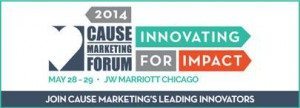
The following is the second in a series of excerpts from materials presented by Mark Feldman at the Employee Engagement workshop session at the 2014 Cause Marketing Forum (CMF) in Chicago. The interactive session brought together businesses, agencies and non-profits to discuss the strategies behind cause-focused employee engagement programs. Here are some quick tips and key lessons for those not able to attend.
_______________________________________________________________
It is essential to distinguish between impact and activity when creating an employee engagement strategy that is an integrated part of your culture, business, brand and CSR. Impact captures how you make a measurable difference on specific social goals. It is the key part in the ‘why’ we do employee engagement. Activity is the ‘what’ employees do in order to have an impact.
We use the employee engagement grid (image below) to plot the wide spectrum of employee engagement activities according to these two criteria, which will differ based on your company’s objectives.

The horizontal axis represents time. Quick, one-off activities such as ‘liking’ on Facebook, sharing a viral video and playing an online game to raise money for a cause fall on the left side. Hands on volunteerism falls towards the middle as it requires more time. On the right side fall more time intensive engagements such as mentoring, loan executives (company executives “on loan” to nonprofit or other organizations) and skills based volunteerism.
The vertical axis represents impact. The broad range of potential employee engagement activities also can also be considered according to the measurable impact on business and society that your company and employees want to achieve. The goal when creating any employee engagement activity is to move from the bottom to the top quadrants where impact is at its highest.
Click here for a copy of the more detailed Employee Engagement Factsheet that was handed out during the workshop.
Read more from the CMF14 session in our following blogs:
8 Things to Consider When Designing A Cause-Focused Employee Engagement Program
